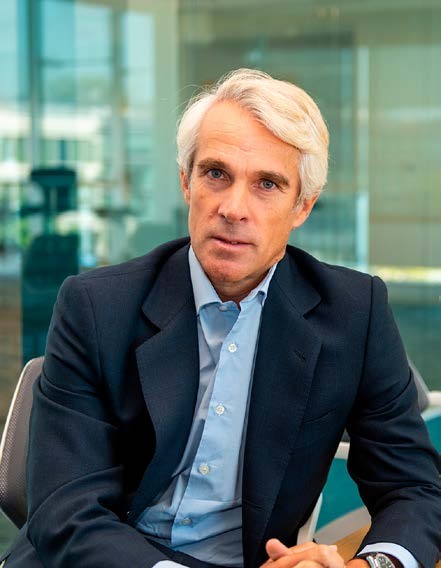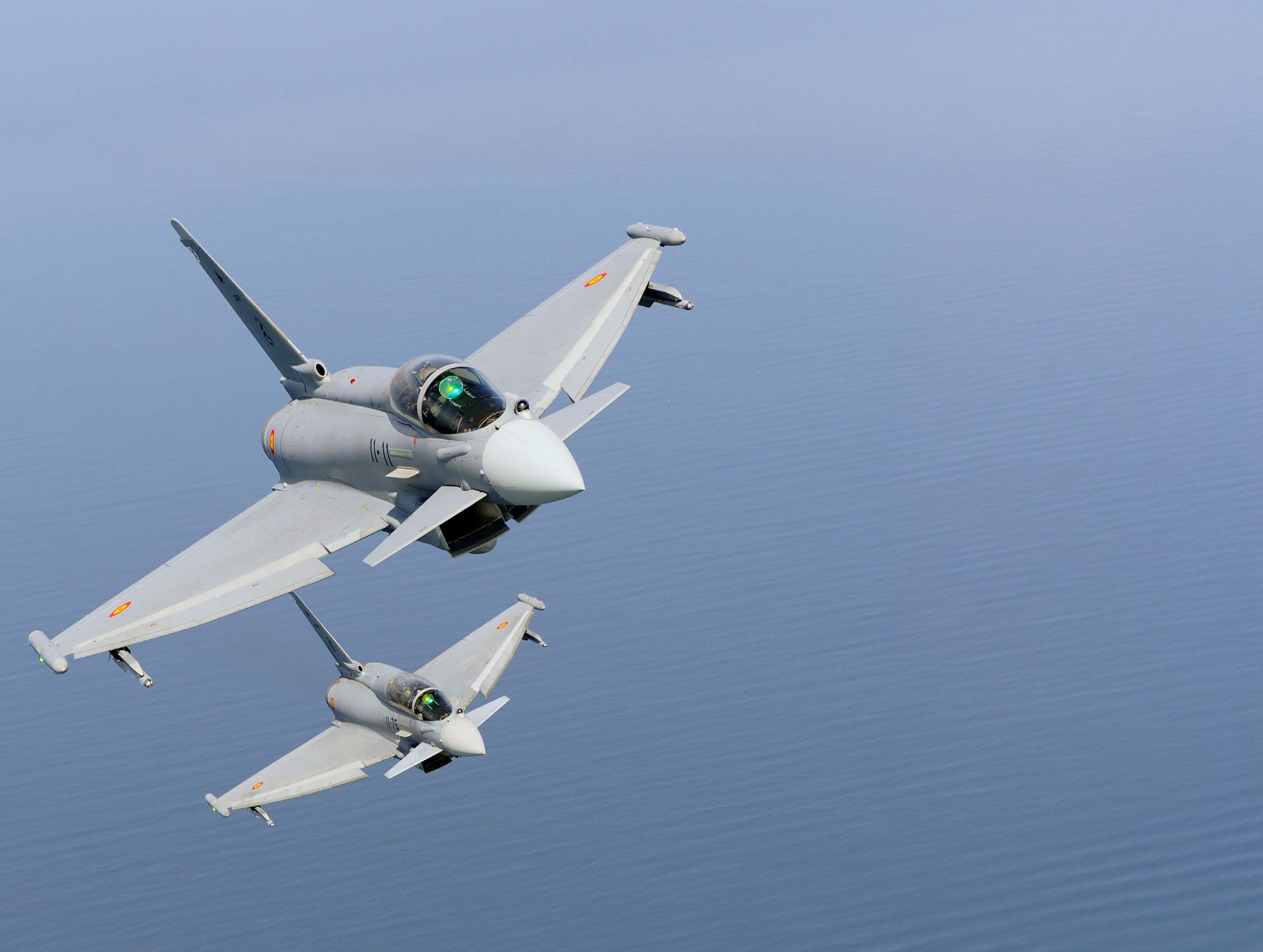At Indra’s facility in Torrejón, north of Madrid, a team of engineers works in special clean rooms making tiny circuit boards.
The hand-crafted miniatures they produce are used in the aircraft’s radar systems. The boards are the size of a fingernail. They are made using gold, which is one of the most effective elements for connectivity.
It takes real skill, the precision of surgeons, to put these delicate pieces of the Eurofighter jigsaw in place.
Indra’s involvement with the Eurofighter programme goes back more than two decades. It works as a valued partner with a whole host of Eurofighter suppliers on different aspects of the programme.
Indra is one of Eurofighter’s main avionics systems suppliers. It plays a key role in the development and production of all the aircraft's systems — from sensors and communications to weapons systems.
Its input is key to both the performance of the aircraft and its survivability and overall mission success.
It has contributed to the development of the Captor radar and the Praetorian DASS system — the fighter’s vital defensive aid package. Indra’s work also includes work on the communications system, the flight control and navigation system, and the test benches that monitor the platform's health to ensure maximum operability.
And in another facility close to Madrid’s international airport a team is working on the simulation systems on which pilots are trained.
Indra’s Defence managing director, Borja Ochoa, explains: “Indra is the second-largest supplier of avionics systems for the Eurofighter Typhoon.

“We are proud that we can say we are one of the only companies involved in the evolution of the self-protection system and the development of the two new versions of the radar, once again highlighting the company’s ability to accelerate the development of the new generation of technologies that European armed forces are demanding.”
EUROFIGHTER OPENS DOORS
Today, Indra is working on the MK1 E-SCAN radar, with Hensoldt (which will be used by Germany and Spain), and the MK2 radar, with Leonardo to be used by the United Kingdom.
It is also contributing to the development of the new capabilities of the Praetorian DASS. These provide it with greater bandwidth, which will enable Typhoon to fly in increasingly hostile environments.
Borja says involvement in the Eurofighter programme has been an important stepping stone in the growth of the Company. Participation has given Indra a platform to show off its technical capabilities and build credibility in the industry.
Our collaboration with our European partners has yielded great results, but above all it has prepared us to tackle together new, even greater challenges that no company or country could face alone.
“Indra has been part of the Eurofighter programme since its inception,” he says. “Today we have the confidence of our partners and the different Air Forces that operate with it. We have demonstrated a great capacity to face the most demanding technological challenges and to meet deadlines. In doing so, we have contributed to the development of one of the most advanced multi-role aircraft in the world.
“Our collaboration with our European partners has yielded great results, but above all it has prepared us to tackle together new, even greater challenges that no company or country could face alone.
“In this sense, I believe that the Eurofighter programme goes beyond the development of the fighter itself and has laid the foundations for jointly tackling new European technology programme.
“Our work on Eurofighter has also opened the doors to customers all over the world.”
PRIDE IN THE BADGE
A global technology business, with a presence in 140 countries, Indra employs more than 58,000 people. Around 500 of these are directly involved in different Eurofighter projects.
That figure is more than 3,000 when you factor in the broader network of external companies Indra works with.
Eurofighter has provided us with knowledge and experience of enormous value and has contributed to the development of the aeronautical industry in Spain.
But the impact of Indra’s involvement in the Eurofighter programme is probably more profound than those numbers suggest.
Borja says: “Eurofighter has provided us with knowledge and experience of enormous value and has contributed to the development of the aeronautical industry in Spain. At the same time, it has strengthened our position to compete worldwide with leading companies.

“It is also important to highlight the pride we all feel in being part of this programme generates. It is very satisfying for us to be working on the development of an aircraft like this, which incorporates the most advanced technologies, collaborating with professionals from other countries who are undoubtedly the best in their areas of specialisation.
“Many of our engineers have dedicated large periods of their professional careers to this programme. And have done so with an enormous level of commitment.”
FUTURE IS BRIGHT
Looking to the future, Spain has shown great commitment to the Eurofighter programme through the Halcon programme. 20 new Eurofighters will replace the F18s at the Gando Air Base in the Canary Islands. A second Halcon phase is under discussion.
Halcon is key to the evolution of the platform and the entire Eurofighter family will benefit from it
Says Borja: “Halcon demonstrates our country's commitment to the Eurofighter programme. Halcon is key to the evolution of the platform and the entire Eurofighter family will benefit from it.
“For example, we are currently equipping the new Eurofighters with state-of-the-art technologies. They will be equipped with the new E-Scan active electronic scanning radar and the Praetorian DASS self-protection system, as well as incorporating improvements in another 15 additional avionics devices that affect communications, cockpit survival, consumables monitoring and platform health management.
“In parallel, Indra is also part of the Quadriga program to deliver 38 new Eurofighters equipped with the most advanced systems to the German Ministry of Defence.
“These acquisitions make it clear that the Eurofighter will remain, well into this century, the main aircraft of the world's most modern air forces and that is why it is so important that we ensure that its capabilities remain up to the challenge. Moreover, the improvements we are making send an important message to the international marketplace that improves our chances of winning future contracts.”
A recent independent report published by PwC revealed the impressive scale of the Eurofighter Typhoon programme’s contribution to economies across Europe. It shows that the programme is helping create and sustain skills, is sparking the development of key technologies and has been the catalyst for the growth of a wide variety of companies. The Indra example brings the report to life.
The PwC report shows that, for the next decade, the programme is set to contribute €58 billion to the GDP of the four core nations’ economies; generate tax revenues of €14 billion for the respective governments; and support 62,700 jobs annually.
Behind the big numbers are 100s of other companies who work to support the programme.
